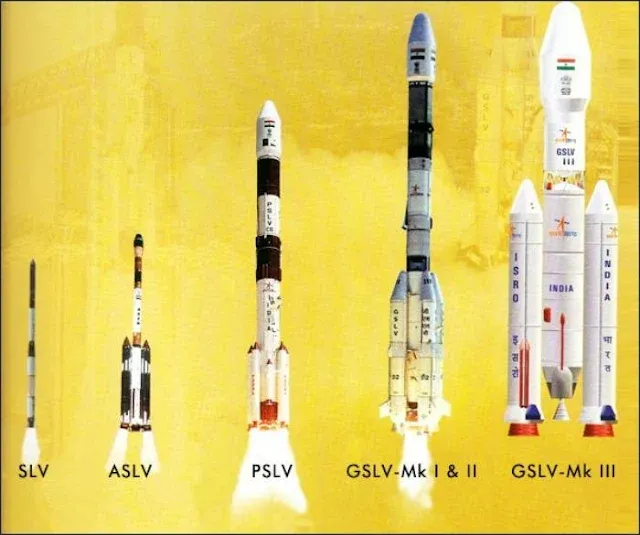Introduction: Why Did the Kaveri Engine Fail?
Before delving into why the Kaveri engine failed, it’s essential to understand the development processes followed by other organizations like ISRO. By analyzing how ISRO gradually built its rocket programs, we can identify the gaps in DRDO’s approach to developing the Kaveri engine.
ISRO's Gradual Approach to Rocket Development
In the 1960s, ISRO began building sounding rockets for upper atmospheric research. These simple rockets could reach altitudes of 20–50 kilometers.

|
| ISRO's rockets and SLVs. | via: IndiaTimes |
Over time, ISRO developed increasingly complex rocket systems, such as the Rohini series of sounding rockets (RH-200, RH-300, RH-560), with the number indicating the rocket's diameter in millimeters.
These early efforts laid the groundwork for more advanced projects.
The Satellite Launch Vehicle (SLV) Project: A Steady Learning Curve
In the 1970s, ISRO began developing its Satellite Launch Vehicle (SLV), the smallest possible satellite launch rocket, capable of placing small satellites into low Earth orbit.
The SLV-3, despite initial failures, succeeded in placing a satellite in orbit in 1979.
Through many trials and learning experiences, ISRO expanded its capabilities, eventually progressing to larger and more complex rockets, such as the PSLV in the 1990s and the GSLV in the 2000s.
Each step is built on the knowledge gained from previous projects, enabling ISRO to develop the robust capabilities it has today.
Key Lessons from ISRO's Approach
The key takeaway from ISRO's approach is that it gradually built knowledge, technology, and experience.
ISRO didn’t jump straight into building the PSLV or GSLV.
Had it tried to develop these complex systems without mastering smaller, simpler rockets, failure would have been inevitable.
The Kaveri Engine: Ambitious, but Complex
The Kaveri engine, designed for fighter aircraft, was intended to deliver 8,000 to 10,000 kg of thrust. However, developing such a high-thrust engine requires significant technological maturity, which DRDO did not have at the time.
.webp)
|
| Kaveri Engine | Image via: BusinessWorld |
While ISRO followed a gradual development process, DRDO aimed to leap directly into developing advanced technology without a foundation of smaller, simpler engines.
The Gas Turbine Research Establishment (GTRE), set up in the late 1950s, began its work on jet engines but lacked a methodical, step-by-step approach similar to ISRO’s.
This led to significant challenges for the Kaveri Engine.
DRDO's Challenges: Lack of Foundational Technology
DRDO’s approach to the Kaveri engine involved trying to develop a complex, high-thrust engine without having first built smaller, less complicated engines for simpler applications.
If GTRE had followed a path similar to ISRO’s, starting with smaller engines and working their way up, the Kaveri engine might have had a higher chance of success.
Also read:
- Indian Air Force to Acquire 24 Second-Hand Mirage-2000 Fighters
- DRDO's Airborne Early Warning and Control System (AEW&C)
- Tejas Flying Record World’s Best, Criticism Unfortunate: Air Marshal Philip
Developing a gas turbine engine, especially one for military jets, is an extremely challenging task that demands years of foundational work and incremental improvement.
The Role of Foreign Technology and Collaboration
One of the key challenges DRDO faced was the lack of a suitable foreign collaboration. The Kaveri engine’s development was hampered by the failure to secure a meaningful partnership with foreign manufacturers of high-thrust jet engines.
Foreign partnerships could have helped DRDO learn from existing technologies, accelerating the engine’s development and possibly avoiding the bottlenecks they encountered.
Conclusion: Lessons Learned
While DRDO’s ambition was admirable, the failure of the Kaveri engine teaches us the importance of building knowledge gradually, following a step-by-step approach to complex projects and securing the necessary partnerships and resources.
Also Read:
- Agni-V: India Successfully Test Fires Ballistic Missile
- Chinese Army Gets New All-Terrain Vehicle for Winter Logistics Support Near LAC
- Indian Navy to approach Defence Acquisition Council For Procurement of Predator Drones
Looking forward, DRDO’s future engine development programs can benefit from these lessons by focusing on incremental innovation, learning from global best practices, and fostering collaborations with established players in the defense and aerospace industries.


No Anti-Nationals, Trolls, Curse, Racial, Political, Irrelevant Comments on Articles. Moderators will ban without warnings.